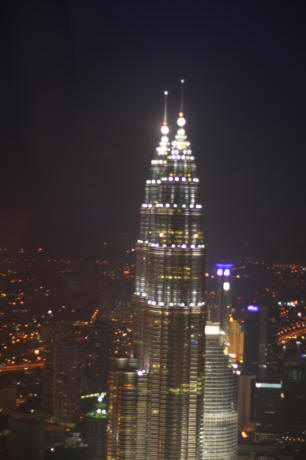|
The Petronas Twin Towers (also known as the
Petronas
Towers
), in
Kuala
Lumpur,
Malaysia

The Petronas Twin Towers (also known as the
Petronas
Towers
), in Kuala
Lumpur, Malaysia
were once the world's tallest
buildings when measured from the level of the main entrance to the
structural or architectural top.
It has since been unseated by the Taipei
101 on October
17, 2003. The
Petronas
Twin
Towers
are currently the tallest twin towers in the world, and it lays claim to being
the world's tallest high rise of the 20th
century. Critics point out that this applies to only one of four height
categories defined by the Council
on Tall Buildings and Urban Habitat - although the three additional height
categories were only introduced as the tower neared completion in 1996,
as opposed to the original category which had been in use since 1969.
[1]
History
The towers, which were designed by Argentine
architect César
Pelli were completed in 1998.
The 88-floor towers constructed largely of reinforced concrete with a steel and
glass facade were designed to resemble motifs found in Islamic
art, a reflection of
Malaysia
's Muslim
heritage. They were built on the site of Kuala
Lumpur's race
track. Because of the depth of the bedrock
the buildings were built on the world's deepest foundation going down some 120
meters and requiring massive amounts of concrete. In an unusual move, a
different construction company was hired for each of the towers, and they were
made to compete against each other. Eventually the builders of Tower 2, Samsung
Constructions, won the race, despite starting a month behind Tower 1, built
by Hazama
Corporation, although Tower 2 ran into problems when they discovered the
structure was 25 millimeters
off from vertical. Due to a lack of steel and the huge cost of importing steel,
the towers were constructed on a cheaper radical design of super high strength
reinforced concrete. High-strength concrete is a material familiar to Asian
contractors and twice as effective as steel in sway reduction. Supported by
23-by-23-metre concrete cores and an outer ring of widely-spaced super columns,
the towers showcase a sophisticated structural system that accommodates its
slender profile and provides from 1300 to 2000 square metres of column-free
office space per floor.
Below the twin towers is Suria
KLCC, a popular shopping mall, and Dewan Filharmonik Petronas, the home of
the Malaysian
Philharmonic Orchestra.








|